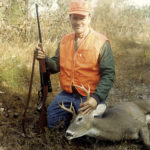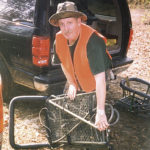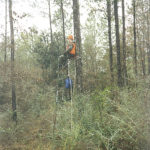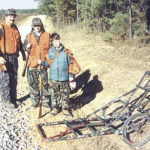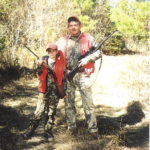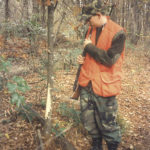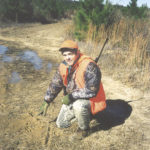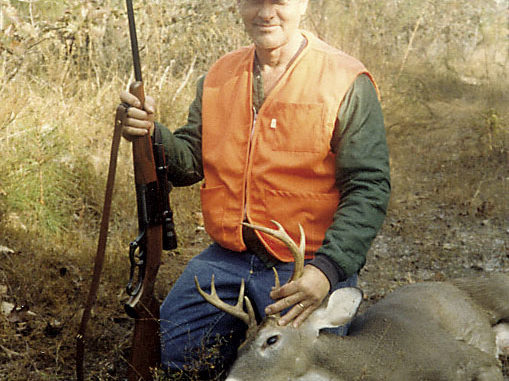
Based upon the numbers, it’s obvious that Clear Creek WMA offers some of the best public deer hunting in the state.
EDITOR’S NOTE: Capt. Paul Titus, Louisiana Sportsman’s GPS guru, is an avid deer hunter. He and a group of buddies have been hunting public land for several decades, and they have incredible success. One of their favorite areas is Clear Creek WMA.
Depending on the weather and, of course, the hunter turnout, Clear Creek Wildlife Management Area usually produces a decent harvest of deer each year. The whitetail deer at Clear Creek are not as large as their cousins at Jackson-Bienville and other Mississippi River Delta WMAs, but the area has produced some nice racks.
Depending on the weather and, of course, the hunter turnout, Clear Creek Wildlife Management Area usually produces a decent harvest of deer each year. The whitetail deer at Clear Creek are not as large as their cousins at Jackson-Bienville and other Mississippi River Delta WMAs, but the area has produced some nice racks.
As in other parts of Area 3, the first deer rut occurs near the end of October and again later in the season. There is a limited-access youth season, a primitive, archery, firearms either-sex (usually split near the end of October and the Thanksgiving weekend) and an extended firearms bucks-only season that usually runs between the two either-sex seasons.
With the proper equipment, you can usually hunt from mid September to mid January for deer and small game and over a month in the spring for turkey.
The reported deer harvested from the Clear Creek area was listed at 200 with 7.7 efforts per deer harvested during the either-sex hunts. The deer harvest in Vernon Parish was listed second-highest in the state.
How to hunt the area
The general topography of the WMA lends itself to hunting deer with a rifle, which is what we use. However, shotguns with buck shot or slugs can be used in the creek bottoms. My closest shot from a tree stand was about 20 yards, but my farthest shot was over 270 yards. There are no sighting-in ranges on the WMA, so get your “zero” in before the hunt.
We usually arrive a day or two before the season, and spend one full day of scouting the area. Yes, we have our favorite areas within the WMA, but because of the timber harvesting, a reaffirmation that deer are still in the area is a must.
In the past, ATVs were allowed almost anywhere in the WMA, but now they may only be used on designated roads and trails. So, you may have to hoof it to cover the areas to be scouted and hunted.
Once we locate deer sign in an area, we try to speculate the reason, time of the day and how frequently the deer were in that area. Don’t laugh, but knowing what rub, scrape, tracks, forage, mast and bedding signs look like are critical to your success. Knowing how to distinguish a scrape line and the entry and exit points of the line will allow you to place your stand in the most opportune location for your hunt. We always welcome a light rain as it helps distinguish the older sign from the newer.
Knowing our past stands, trails, creek crossings and “saddle trails” between the hill tops has given us an upper hand on our scouting duties, but we still check out the areas. We always select more than one hunting stand area as the WMA rules do not allow you to reserve a location. It is always a first-come basis for the hunting on a WMA. By having a backup hunting location, your day is not wasted.
Remember to practice all normal and hunting courtesies when encountering other hunters in the woods. Respect them and their hunting efforts. Do so as you would want them to respect yours. A simple whistle or flashing your light toward the individual will usually deter trampling in or through your hunting area. If they do not heed your signal, just suck it up, and continue your hunting. If a vehicle is already parked at the trail head that you were going to use, go to your alternate hunting site.
Get off the ground
If there is one main piece of equipment that can be attributed to our success, it is the use of portable ladder and climbing stands.
An elevated stand allows the uninitiated hunter the opportunity to stretch and move. Such movement on the ground would almost certainly give your presence away; in addition, your scent will be all around the ground by your stand area. Besides giving you an excellent and extended view of the area, an above-ground stand allows your scent to be carried away by some of the upper air currents.
One time while using pure turpentine from a paint store as a cover scent on my boots and on the tree at the base of my 15-foot-high climbing stand, I watched a doe, during a bucks-only season, actually rub and scratch her side on the trunk of the very tree where I was located. She did not even have an idea that I was directly above her head. The cover scent worked. It was a fascinating to watch her behavior for over four minutes. Being patient and returning to the same stand the next day allowed me to harvest a nice 7-point buck.
We usually hunt a selected stand area for at least two days, even if we did not see a deer. If, however, we find fresh sign, or actually see deer in the area, we will extend the time that we stay in that stand area. Of course, we may move the stand location, if necessary, to an improved tree or location to cover the area where we saw game or important deer sign.
Markers, scents, calls and gear
We used to employ the use of flagging tape to mark the trails to our stands, making sure that all of the tape was removed as we exited the area, but now with the help of GPS units, we use only reflective tacks or the reflective clothes pin-type markers to indicate the way to our stand areas. These tacks are placed in strategic locations or turns along the routes to our stands.
Some of us use a cover scent such as the aforementioned turpentine or some other such commercial scent. A few of us use a deer scrape scent to entice that wary buck just a little closer or to hold their interest for just a few moments longer. We also use a bleat call, and one member of our group uses rattling horns.
These calls and rattling horns are mainly used to delay the departure of a quarry that may be seen, and not to actually “call” the game into our sights. I once stopped a doe in her tracks by using the bleat call. I also use a rubber-ball squirrel call to mask any noise that my movements may make when I am on the ground still-hunting an area.
We usually hunt in at least pairs for safety, and we carry small walkie talkie-type Family Radio Service (FRS) radios, which are turned on at certain predetermined times or whenever a shot is heard. These radios are an added safety feature. We’ve found that these radios have a range of about five miles in the woods, and are a comfort in knowing that another soul knows where your are hunting.
If you are hunting from an above-ground stand, bring along a small pair of binoculars. You will not need a pair of marine glasses or those designed for poor light. A very simple pair of the small pocket type in 8×21 size will do. Such a pair of binoculars allows you to scan the area around your elevated stand with ease. These glasses provide close-up views of any movement in the coverage area, and because you are above the ground, your movements will not usually be detected by the game. It will give you a heads up on the size, sex and type of approaching game, and will still give you enough time to shoulder your weapon.
I usually secure these items with a piece of nylon twine and a safety pin that secures to the pockets on my hunting vest. This safety cord saved me dropping some of the items from these aerial stands.
Another item we have found indispensable is a game carrier. Our group has expanded to having two such carriers. Ours are the two-bicycle-wheel types that can hold up to 300 pounds and can be pushed or pulled. The game is strapped to the “V” frame between the two bicycle wheels, and the load is then usually pulled. The larger the wheels the better, as the larger wheels allow the user to maneuver the carrier over small obstacles such as down tree limbs and through small creeks easier than those with smaller wheels. The carriers that we have can be folded into compact bundles for transporting in a vehicle and opened and rolled to the area where needed. Each hunter knows in which vehicle the carriers are located and has keys to that vehicle.
These game carriers are also a great relief in getting our stands in and out of the hunting areas. Believe me, these contraptions have saved many a hunting day by allowing us to get the game back to our trucks without busting a gut. We are not road hunters. Our strands are usually over 1,000 yards from the designated roads. These game carriers are a big help.
By getting deep in the woods early away from the designated roads, we noticed that the road hunters would cause the game to move deeper in the woods toward our positions. They were in effect pushing the game toward our positions when they proceeded to their stands.
The areas
We have observed deer on the hilltops, on the sides of the hills and in the bottoms by the creeks. There are many intermittent creeks on the hillsides that flow when wet to the many larger creeks in the WMA. Wolf, Forker, Low John, Red Bank, Damrel, Pocosin, Little Red Bank, Mill and, of course, Clear are some of the many creeks that crisscross the WMA, and are prime bottomland areas. These bottoms and the adjoining hill areas are productive hunting sites.
It seems as if the hilltops are more productive during windy conditions and during the heat of the day. On cold days, we have found deer lying down on the lee side of a hill in the sun. I personally have jumped deer on the hilltops during a light rain. It seems as if the rain defeats their sense of hearing and smell in the heavy tree areas, and they seek the hilltops watching the approach routes.
The clearcut areas with about two or three years of new growth are famous for holding such game. Put yourself in the deer’s position. Think how you would access the hillside or creek crossing, and look for sign of the deer. Once found, set up your stand by the deduced egress/exit routes.
Don’t sleep in on a rainy day. I took a very nice buck during a light rain. I had the woods to myself that day, and any noise my movements caused was dampened by the effects of the rain. I usually do not hunt in a driving rain or a lightning storm, but a light rain falling can be a very productive time to hunt.
Lately, some of the pipeline rights-of-way have winter grass planted for food and erosion purposes. If you can safely hunt the right-of-way where that erosion grass is planted, do so and bring a pair of binoculars.
The old food plots
There were once several areas that were designated as food plots. They were cultivated, fenced and planted with various types of deer food. Although these food plots are no longer maintained, I believe that they still attract deer if you know where they were once located. I have seen the ground torn up in these old sites. This may be because of fertilizer that was once used in the area growing the food crops.
Hunting specifics
The either-sex dates offer hunters a good opportunity to harvest deer in the area. The either-sex days are usually a weekend at the end of October and the extended Thanksgiving weekend in addition to a youth hunt, primitive season and an archery segment at the WMA.
We, however, like hunting during the bucks-only segment, as we normally have the woods to ourselves. We have taken quite a few very nice bucks during this time. The racks of three such bucks are on my office wall.
If you are staying at the free campground, you must bring your own restroom facilities, potable water and, of course, a place to sleep. If you intend to stay a few days, bring both warm- and cold-weather gear and, of course, something for the rain. I have seen the temperature drop over 20 degrees after a rain front came through.
It is also very wise to bring the tools needed to maintain the campsite in addition to your normal hunting requirements. Extra ice chests are a must in the event that you are able to harvest some game and are staying a few days.
Get there early for the either-sex hunting seasons as the camping area can get quite crowded.
An advantage on the Thanksgiving either-sex season is the WMA will open for bucks-only prior to the either-sex hunting time. That means that you can scout/hunt for your stand and hunting locations.
The turkey season is usually posted and released by mid December of each year. My hunting buddies and I have been asked by wildlife agents to report turkey sightings in order for them to assess the population. Although we have not hunted turkeys on the WMA, many a day has been interrupted by a flock of turkeys strolling though my stand area.
Our group has been hunting this area since the 1960s when it was named Lutcher Moore. Later the name was changed to Boise-Vernon and is now Clear Creek, but the area remains basically the same, except that the fence lines between the pastures, as the sections were called, were mostly removed and the campsite area was enlarged.
These fence lines had cattle guards across the roads, and the land was leased for cattle and horse grazing, which sometimes made it hard to hunt. These lease arrangements are no longer in place, but some of the old barbed wire fencing is still along the old fire breaks.
Keep that in mind when deer hunting this area, as these fence lines separated the various areas designated as “pastures.” These fence lines usually have a 10- to 15-foot-wide fire break that ran between the checker board timber areas and pastures. The fence line in some areas would even cross some of the many creeks that are located in the area.
We have found that the old fence lines are practically deer interstate highways. It is not uncommon to see deer hair on the top wire of these fences at locations where the deer were crossing. A strategically placed climbing or portable ladder stand along or next to these old fence lines can be a very productive hunting area.
